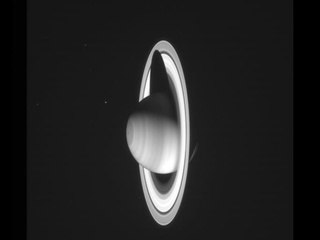Winners
Kaia Hayashida, Sarah Morgan
Grade 7-8

Contest:
2018-2019
Topic:
Enceladus
School:
Auburn Middle School, Auburn, ME
Teacher:
Nicole Melcher
For 60 years NASA scientists have been studying space, looking for signs of life. The Cassini Mission sent information to Earth for 13 years. During that time, we were able to learn incredible things about one of Saturn’s moons, Enceladus. The ice-covered surface conceals a liquid water ocean underneath it, and jets of water erupt from its surface. Saturn’s moon Enceladus, is the best option to send a spacecraft to for further studying. Besides Earth, Enceladus is one of the only known celestial bodies that satisfies almost all of the requirements necessary for supporting life as we know it.
Firstly, the Cassini Mission has collected a sample of the plume from Enceladus. When Cassini was launched in 1997, Cassini had only the technology of its time. NASA should send another mission equipped with newer technology to test for life, specifically to Enceladus to collect samples of the ice and water. We can collect core samples of ice to test. If there are microorganisms living in the ice, it would be a critical discovery for everyone and the only life that we have found outside Earth’s atmosphere.
Secondly, Cassini has revealed there to be a liquid water ocean below Enceladus’ icy crust. This ocean wraps around the entire expanse of Enceladus. Scientists know that where there is water, there is life. According to McCartney, Brown, Wendel, and Bauer in the article “Complex Organics Bubble up from Enceladus,” “Previously, Cassini had detected small, relatively common organic molecules at Enceladus... Complex molecules...are rare beyond Earth. The presence of the large complex molecules, along with liquid water and hydrothermal activity, bolsters the hypothesis that the ocean of Enceladus may be a habitable environment for life,” as written on June 27, 2018.
Finally, the hydrothermal vents on the ocean floor are of great significance because they are a source of energy and nutrition for bacteria. Scientists have detected the presence of hydrogen in the plume given off by Enceladus. This is key because the hydrogen produced by hydrothermal vents could serve as an energy source for any microbes living there. With all that we have learned about Earth, the origin of life is suspected to have derived from extremophiles, such as the bacteria living near our own hydrothermal vents. With these same conditions on Enceladus, it could lead to the start of life there too.
In conclusion, NASA should pursue their exploration of Enceladus. Enceladus, has proven to be one of our solar system’s most intriguing destinations. Since 1969, when Neil Armstrong walked on the moon, our goal has been to find other life in the solar system. Enceladus poses strong opportunities for life through its global ocean, icy crust, and hydrothermal activity. When we first observed Enceladus, it was simply one of Saturn’s many moons. Further investigation has proved it to be much more. This icy moon is an opportunity to spread the human population further than we ever thought to be possible–and just maybe–discover that we are not alone.
